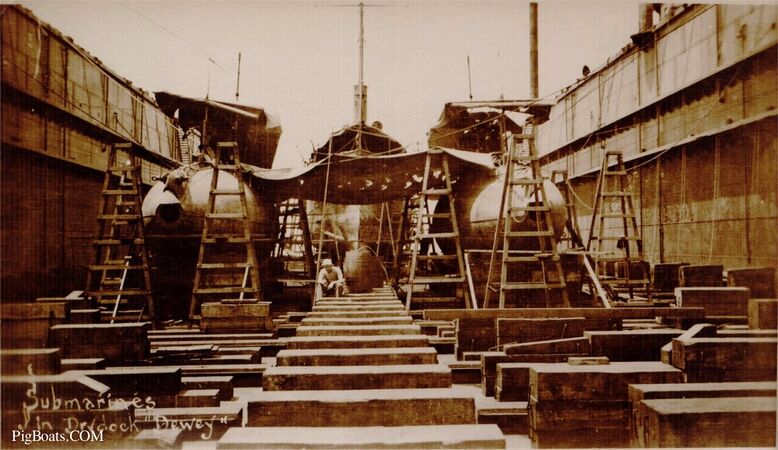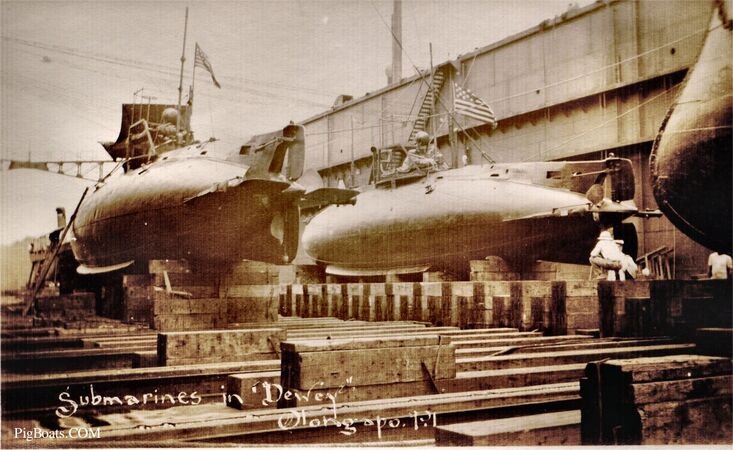General A-class photos: Difference between revisions
No edit summary Tag: Manual revert |
Pbcjohnston (talk | contribs) Added drydock photos |
||
| Line 45: | Line 45: | ||
{{#ev:youtube|id=44EB6xcWxKg|alignment=left|dimensions=500x300}} | {{#ev:youtube|id=44EB6xcWxKg|alignment=left|dimensions=500x300}} | ||
This video is of one of the A-class submarines running builder's trials in Great Peconic Bay, New York, approximately 1903. Please disregard any reference to the [[Holland|'''USS Holland (Submarine No. 1)''']]. The person that posted the video misidentified the boat. The crewmen on the boat are all wearing civilian clothes, so this indicates that this is the builder's trials, a set of sea trials that take place after the boat is completed but BEFORE it is accepted and commissioned by the U.S. Navy. All of the men visible are Holland employees and not Navy sailors. Second, in the opening scenes you can see the tugboat Kelpie in the background. This was a Holland Torpedo Boat Company craft that accompanied the A-class boats while on sea trials. Most likely the camera that shot this film was aboard the Kelpie in Great Peconic Bay. The presence of the Kelpie shows this location to be the Holland Torpedo Boat Company facility in New Suffolk, NY on Long Island. The location then would rule out the submarines Grampus and Pike, which were built at Union Iron Works in San Francisco. Plunger, Adder, Moccasin, Porpoise, and Shark were all built at the Crescent Shipyard in Elizabethport, New Jersey and immediately moved to the Holland facility in New Suffolk for testing. As for a rough guess as to the boat's identity, we would speculate that it may be the Adder. She was one of the first boats to be tested with a periscope, which is clearly seen in this film. | This video is of one of the A-class submarines running builder's trials in Great Peconic Bay, New York, approximately 1903. Please disregard any reference to the [[Holland|'''USS Holland (Submarine No. 1)''']]. The person that posted the video misidentified the boat. The crewmen on the boat are all wearing civilian clothes, so this indicates that this is the builder's trials, a set of sea trials that take place after the boat is completed but BEFORE it is accepted and commissioned by the U.S. Navy. All of the men visible are Holland employees and not Navy sailors. Second, in the opening scenes you can see the tugboat Kelpie in the background. This was a Holland Torpedo Boat Company craft that accompanied the A-class boats while on sea trials. Most likely the camera that shot this film was aboard the Kelpie in Great Peconic Bay. The presence of the Kelpie shows this location to be the Holland Torpedo Boat Company facility in New Suffolk, NY on Long Island. The location then would rule out the submarines Grampus and Pike, which were built at Union Iron Works in San Francisco. Plunger, Adder, Moccasin, Porpoise, and Shark were all built at the Crescent Shipyard in Elizabethport, New Jersey and immediately moved to the Holland facility in New Suffolk for testing. As for a rough guess as to the boat's identity, we would speculate that it may be the Adder. She was one of the first boats to be tested with a periscope, which is clearly seen in this film. | ||
[[File:Red bar sub.jpg]] | |||
<gallery mode="packed" widths="400px" heights="300px"> | |||
File:A-class Dewey Dry Dock-Bow View.jpeg | |||
File:A-class submarines in the Dewey Dry Dock-Stern View.jpg | |||
</gallery> | |||
</center> | |||
Two unknown A-class submarines in the floating drydock USS Dewey (Drydock No. 1) at Naval Station Subic Bay, Philippines, approximately 1910. The ship in the dock with the submarines is likely the gunboat USS Elcano (Gunboat No. 38). The oppressive heat of the Philippines is kept somewhat at bay by the extensive use of tarpaulins as sunshades. The second photo shows the work nearly complete, with the tarps and some of the access ladders removed. The open domed access hatches for the submarines are visible on their conning towers. | |||
<small>Photos in the private collection of Ric Hedman.</small> | |||
[[File:Red bar sub.jpg]] | [[File:Red bar sub.jpg]] | ||
Revision as of 20:04, 8 March 2024

Milne Special Collections, University of New Hampshire Library, Durham, N.H.
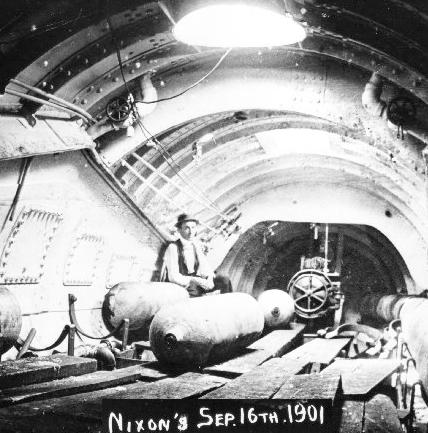
An A-class submarine under construction at the Crescent Shipyard in Elizabethport, NJ., September 16, 1901. This is looking forward from the middle of the boat and shows a worker sitting near high pressure air flasks that have not yet been installed. In the background is the boat's single torpedo tube. Based on the level of completion and the date on the photo, this boat is either Porpoise (Submarine No. 7) or Shark (Submarine No. 8).
Milne Special Collections, University of New Hampshire Library, Durham, N.H.

Another A-class boat under construction at the Crescent Shipyard. This is also looking forward from the middle of the boat. There is a gauge panel above the torpedo tube, likely for the air flasks. The sign on the tube door says "Hands Off".
Milne Special Collections, University of New Hampshire Library, Durham, N.H.
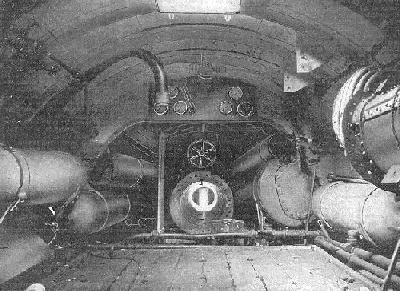
This is a smiliar view to the ones above, but this time the boat is nearly finished. Both the breech and muzzle doors of the torpedo tube are open. Note the wood planking over the battery well in the foreground.
Photo in the private collection of Ric Hedman.
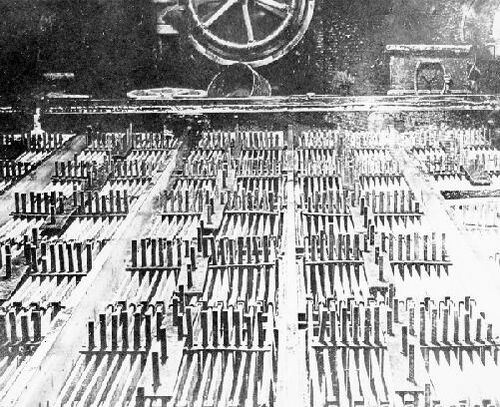
An A-class battery in the process of installation. The upright wooden pegs are called "cribbing" and are used to separate the indivdual lead plates of each battery cell. When full, the electrolyte solution would be right at the top of lead plates. This open top battery was extremely dangerous to work with, but it actually worked pretty well for 1901 technology. The breech door for the torpedo tube can be seen in the center background.
Milne Special Collections, University of New Hampshire Library, Durham, N.H.
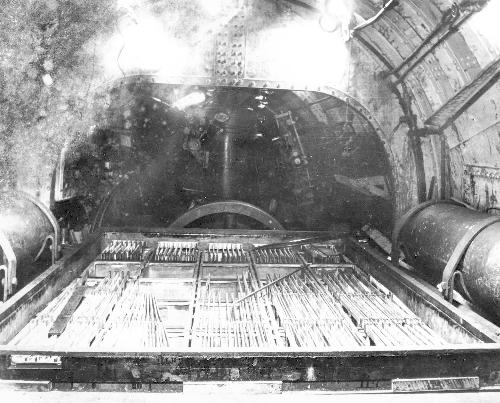
A similar view, but looking aft into the engine room. The large flywheel for the Otto gasoline engine can be seen just beyond the battery.
Milne Special Collections, University of New Hampshire Library, Durham, N.H.
This video is of one of the A-class submarines running builder's trials in Great Peconic Bay, New York, approximately 1903. Please disregard any reference to the USS Holland (Submarine No. 1). The person that posted the video misidentified the boat. The crewmen on the boat are all wearing civilian clothes, so this indicates that this is the builder's trials, a set of sea trials that take place after the boat is completed but BEFORE it is accepted and commissioned by the U.S. Navy. All of the men visible are Holland employees and not Navy sailors. Second, in the opening scenes you can see the tugboat Kelpie in the background. This was a Holland Torpedo Boat Company craft that accompanied the A-class boats while on sea trials. Most likely the camera that shot this film was aboard the Kelpie in Great Peconic Bay. The presence of the Kelpie shows this location to be the Holland Torpedo Boat Company facility in New Suffolk, NY on Long Island. The location then would rule out the submarines Grampus and Pike, which were built at Union Iron Works in San Francisco. Plunger, Adder, Moccasin, Porpoise, and Shark were all built at the Crescent Shipyard in Elizabethport, New Jersey and immediately moved to the Holland facility in New Suffolk for testing. As for a rough guess as to the boat's identity, we would speculate that it may be the Adder. She was one of the first boats to be tested with a periscope, which is clearly seen in this film.
Two unknown A-class submarines in the floating drydock USS Dewey (Drydock No. 1) at Naval Station Subic Bay, Philippines, approximately 1910. The ship in the dock with the submarines is likely the gunboat USS Elcano (Gunboat No. 38). The oppressive heat of the Philippines is kept somewhat at bay by the extensive use of tarpaulins as sunshades. The second photo shows the work nearly complete, with the tarps and some of the access ladders removed. The open domed access hatches for the submarines are visible on their conning towers.
Photos in the private collection of Ric Hedman.
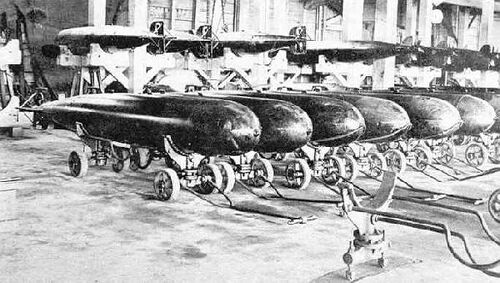
A host of Whitehead Mk 3 torpedoes stored at Naval Station Cavite, Philippines, 1906. These were the weapons used by the A-class submarines. They weighed 845 lbs. and were 11.6 feet long and 17.7 inches wide. They had a range of 800 yards at 27.5 knots and carried a warhead of 118 lbs. of wet gun cotton. These were the first torpedoes that had a gyroscope. This greatly improved accuracy.
Photo in the private collection of Ric Hedman.
Page created by:
Ric Hedman & David Johnston
1999 - 2023 - PigBoats.COM©
Mountlake Terrace, WA, Norfolk, VA
webmaster at pigboats dot com

